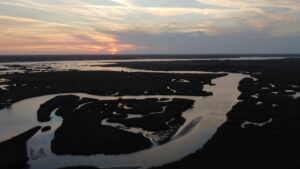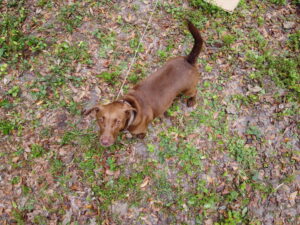How Far can you really fly the new DJI Ocusync Mavic Mini 2 ?

The DJI Stated answer would be the max control distance is 10 km with the excellent new Ocusync Control System ! That is what is stated in the official DJI specs sheet as the maximum range of the control system.But can you really fly 10 km out and expect to come back to the homepoint ?Just fly 10,000 meters or about six miles out from Homepoint is a long way. To fly 20,000 meters or little over 12 miles there and back is a super long long way for any recreational drone.
Let’s do a little math.
DJI specs say Mavic Mini 2 can fly at a steady rate of 14m/second for 30 minutes in calm or no wind conditions . So 14m/s x 60 seconds / minute x 30 minutes equals 25200 meters or 25km in calm conditions or over 15 miles. So in theory yes you could go to the maximum distance of the controller and come back. For a distance comparison much larger DJI Mavic Pro can go 15.5 miles hr for 27 min or just 7miles total distance! Mavic Mini 2 can go about same Mavic Pro on paper. I wouldn’t try it but others have.
The farthest out I have watched so far on Youtube is just over 11,100 meters out one way or 6.9 miles. Another Max farthest out with a return was 13,600 ft out far out and back. The return trip was nail biting. The Mavic Mini 2 tried to force land at 8% battery but he kept pushing the stick forward. He ended with the Mavic Mini 2 coming down at his feet with a zero battery . WOW over 27000 ft total in flight distance or about 5 miles with strong wind warnings. So yes in reality in extreme condition the Mavic Mini 2 can go over 5 miles! That seems mind-boggling to me for such a small 249 G drone. I can remember attaching special extended antennas to my Phantom 4 controller. I never got it past 6000 meters or about 3.5 miles out without disconnection.

We have proven that yes the Mavic Mini 2 is capable and can go out 10km(FCC) .
Mavic Pro is 7km (FCC) That said, that is in perfect conditions. If there are interference buildings or other obstructions transmission range can be much much less.I have had disconnections at less than 500 meters with my original Mavic Mini . DJI specs say strong interference from Urban Landscapes limited line of sight and many competing signals distance is approximately 3 km.
Medium interference areas like a suburban landscape open line of sight and some competing signals is 6 km. Low interference open landscape abundant line of sight you no or very limited competing signals is approximately 10 km. I usually fly in an area with a high density of other signals. As soon as I take off I will get a warning usually.
With my original Mavic Mini I would have some problems as soon as I got past about 1000m. Farthest out without complete disconnection was 3300 m. I have had my new Mavic Mini 2 out that far with no problem. Just a little jumping on the screen.
I Have not taken my Mavic Mini 2 out till it disconnects nor will I hope. Not for a little while. I’m not that brave yet or have that much money to lose my new Mavic Mini 2 this quickly just testing the distance limits.

Now if you listen to the FAA strict guidelines then you need to keep any drone you flying recreationally in direct line of sight always. Under rule FHA line of sight rule 107.31 Visual line-of-sight aircraft operation 2020.
Basically you must unaided of any other corrective lenses like binoculars to be able to always be able to see your drone from where you’re standing with the controller. Now the law does allow a visual observer but you must be in direct communication with him at all time. You must know drones aircraft location and must be able to determine altitude and direction of flight . Also you must be able to observe the air space for other air traffic or hazards you . Be able to determine if the unmanned aircraft is endangering the life or property of others throughout this whole flight the remote control pilot must be able to see and manipulate the unmanned aircraft system or a visual Observer. The distance is determined obviously by how well you can see and how big your drone is.
A larger drone you can see farther away a smaller drone has to be closer. FAA may use what is called a visual line-of-sight calculator to determine violations; it uses several assumptions. First you have 20/20 vision, second you are looking at an on center view of the drone or unmanned vehicle you’re operating in regular daylight hours not low light. There is no fog , vapor , clouds or obstructions of the air. Last thing that is lacking is contrast of the Drone color to get optimal contrasting with the sky. a red color shows up much more than just Gray of the Mavic Mini 2.
I will not get into regulations but for Night Flight
You must have some kind of night light strobe to meet regulations .That is a whole another blog. I used 6 inches as the basic size back width you can see of the Mavic Mini 2 . The visual line of sight calculator program I used for the Mavic Mini 2 gave me a distance of 1718 ft. I can tell you from experience I can’t see the Mavic Mini 2 that far away. I know from many flights that the end of the retention pond in front of my house is a little over a thousand feet. About the end of the retention pond I pretty much lose all vision of the Mavic Mini 2.
I could easily see my Phantom 4 hovering at that distance. I use this distance 1718ft as a benchmark, obviously if you have flight records showing you are 6000 ft out you are far exceeding line of sight rules could be easily argued by the FAA .
As a general rule of thumb and keeping the FAA happy.

I like to keep my drone in line of sight. For most pictures I want to take and video my drone can easily be in line of sight. You need to be able to see the Drone to safely take the pictures without crashing. I have flown with video only out of line of sight . I don’t do it lightly. Anything can happen when you can’t see your drone. A strong gust of wind can come along and take it off course and into a tree. Mavic Mini 2 has NO AVOIDANCE SENSORS ! So knowing where your drone is very Important. It’s all up to you to keep your drone safe. As always Keep on Dronin
Written by Greg Desowitz
